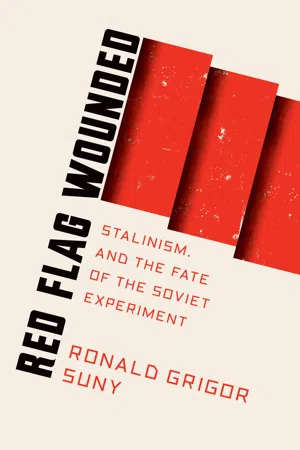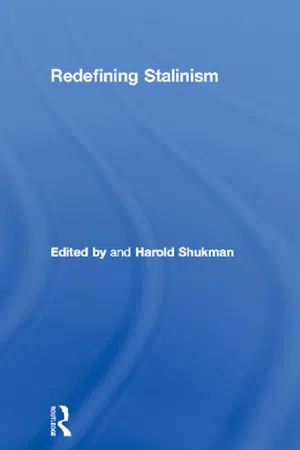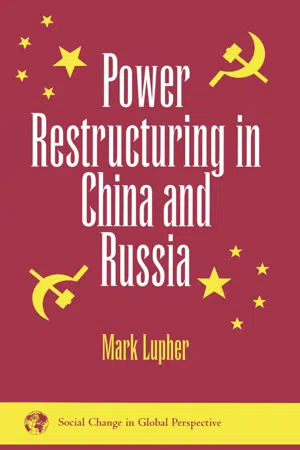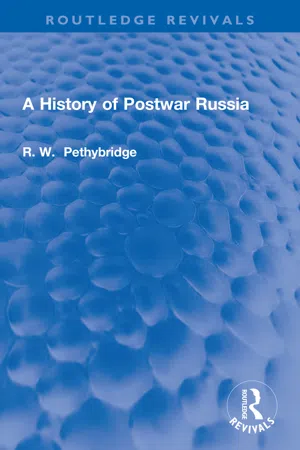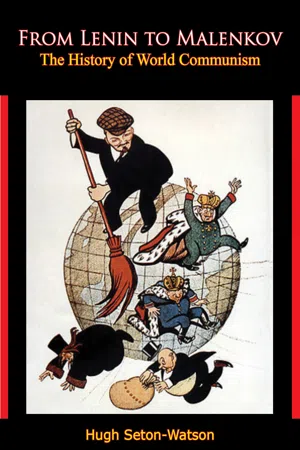History
Stalin
Stalin, also known as Joseph Stalin, was a Soviet leader who ruled the Soviet Union from the mid-1920s until his death in 1953. He implemented policies of rapid industrialization and collectivization, but also carried out purges and repression, resulting in millions of deaths. His leadership had a profound impact on the course of world history, particularly during World War II and the early Cold War period.
Written by Perlego with AI-assistance
Related key terms
Related key terms
1 of 4
Related key terms
1 of 3
6 Key excerpts on "Stalin"
- eBook - ePub
Red Flag Wounded
Stalinism and the Fate of the Soviet Experiment
- Ronald Suny(Author)
- 2020(Publication Date)
- Verso(Publisher)
So powerfully embedded in the Soviet experience was the autocracy and the Terror that in attempting to disentangle Stalinism from the Soviet system, that system itself fell apart. The Soviet past has never just been about one country at one time but about the hopes, rightly or wrongly placed, about alternatives in human history. For the Right, and for many liberals, the collapse of actually existing socialism indicts socialism in all its forms and sanctions capitalism as the only possible modern organization of human life. The utopia of the market is imagined as the resolution of the social problems that state “socialism” could not solve. But, rather than replacing one archaic ideology with a refurbished belief in the invisible hand, historians might do what they do best and introduce complexity, skepticism, and uncertainty into their stories about Stalin and the Soviet experiment. 2 Stalin and His Stalinism: Power and Authority in the Soviet Union, 1930–53 This chapter answers a deceptively simple question: How did Stalin rule? How did he maintain his authority while establishing a personal autocracy? 1 His extraordinary and brutal political achievement was to act in the name of the Communist Party and its Central Committee against that party and Central Committee, while remaining the unchallenged head of party and state and, evidently, a vastly popular leader. At the end of the process, his absolute grip on power allowed him to declare black white and completely reverse the foreign policy of the Soviet Union and the line of the Comintern by embracing Nazi Germany in a nonaggression pact - eBook - ePub
- Harold Shukman(Author)
- 2004(Publication Date)
- Routledge(Publisher)
The monolithic Stalinist government is a myth’. 32 But only a few lines later he adds, ‘The totalitarian state…has encompassed the entire economy of the country as well. Stalin can justly say… “La Société, c’est moi”’. 33 Such a lapse would normally be attributed to Trotsky’s penchant for the sweeping historical metaphor. In the case of his biography of Stalin, from which these lines are taken, there is often an additional reason given: Trotsky was ‘too close to the subject’; his normally lucid train of thought hindered by his personal involvement in the events that led to his own catastrophic political end. 34 This curiosity, especially when viewed in light of later writings by a host of scholars from a variety of points on the political spectrum, but who all exhibit a similar tendency, can most fruitfully be described as a form of ‘historical parallax’, with the apparent change in the position and nature of the object— Stalin—actually being caused by a change in the position of the observer. Employing a static frame of reference, the resulting inconsistency can hardly be avoided. This phenomenon is summed up best by McAuley when she likens the ‘Stalinist’ view of Stalinism to that put forward by the totalitarian school: Both depicted the Soviet period from 1917 to 1953 as one in which aims remained unchanged, both saw the party as somehow still the same party because its ‘ideology’ (that is, the rhetoric of Marxism-Leninism) remained the same; both emphasized the guiding nature of something called ‘Marxist-Leninist ideology’ and granted Stalin almost superhuman powers of control over society. 35 In a chapter devoted to the ‘Social Ingredients of Stalinism’, Pethybridge shows how severely the parallax view—and in his case multi-parallax—can hamper an assessment of the subject - eBook - ePub
- Mark Lupher(Author)
- 2018(Publication Date)
- Routledge(Publisher)
It is certainly mistaken, for example, to speak of Stalin’s interest in “populist control from below.” 172 Once competing centers of official and elite power had been destroyed or neutralized and more reliable and pliable leaders put in place, the authority of the new leaders and their power over the masses was reaffirmed. Just as cultural revolution radicalism was abruptly terminated in June 1931, Stalin in October 1937 condemned radical “excesses,” declared it wrong to persecute all leaders, and decreed that since the Soviet management cadre and intelligentsia were now of proletarian origin, they deserved the trust of the Soviet people. 173 But power relations had been fundamentally transformed by the late 1930s. The Great Purges targeted most explicitly the Soviet political elite that had come to power in the 1920s and grown mighty in the course of collectivization and industrialization. 174 As these high-ranking political, economic, and military officials were either destroyed or forcibly subjugated to a highly concentrated amalgam of Stalinist personal rulership, police power, and central ministerial hegemony, the dependent and uncertain position of all Soviet elites was underscored once and for all. As I discuss in Chapter 5, curbing the autonomy of officialdom and preventing the emergence of competing centers of power were perhaps the most important political aims of what Seweryn Bialer termed the “mature Stalinist system.” 175 Yet in the decades following Stalins death, the contest between Soviet rulers and Soviet elites would be renewed and their relationship redefined, this time with very different results. Notes 1 Carl J - eBook - ePub
- Roger Pethybridge(Author)
- 2021(Publication Date)
- Routledge(Publisher)
CHAPTER IIStalinISM AT HOME, 1945–1953
Stalin AND HIS AIDES
The Second World War changed the face of Europe, involved the United States once and for all in international affairs, and sparked off a chain of colonial revolutions in Asia and Africa. The domestic policies of all save one of the participants in the war altered radically, the defeated states were compelled to make a fresh start; the democratic victor nations, with the exception of the United States, voted for new governments and policies; but even the United States had a change of leadership.Russia alone acted as if the war had never happened. She was a victor nation under totalitarian rule. Roosevelt died at his work, Churchill was voted out of office, but Stalin remained in power, more secure than ever as a result of his military triumphs. The figure of Stalin dominated Soviet history from the time of Trotsky’s downfall in 1927 until his own death in 1953, and his memory still casts a long shadow over it even now. Any estimation of Soviet politics in the postwar years must start with an account of the man and those who occupied positions of power under him.In the preceding chapter no distinction was made between Russian and Stalinist policy, since they coincided. After 1945 Stalin remained at the head of both the party and the government machinery by virtue of his positions as the general secretary of the party and as chairman of the Council of People’s Commissars (Ministers, after 1946), respectively. These posts, and his control over the secret police, enabled Stalin to penetrate into any sector of Soviet life, enforce all his designs, and prevent the rise of likely rivals for power. The victorious course of the war merely served to shore up his unassailable position and enabled him to reassert his control over national life with great rapidity after 1945.Retrenchment and a return to the status quo - eBook - ePub
- Robert Wesson(Author)
- 1978(Publication Date)
- Hoover Institution Press(Publisher)
Chapter 5Stalinism in PowerTHE CONQUEST OF THE PEASANTRYWith the defeat of the moderates, who were mislabelled "rightists," Stalin was prepared to reverse the party's reversal of Lenin's post-civil war economic policy and to carry out the transformation and harnessing of the country, in agriculture, industry, and culture. This Stalinist transformation was a veritable second revolution, as it has often been called, a revolution that was not made by "spontaneous" forces, but imposed by the "conscious" powers above. It became possible at the end of the 1920s because dissent and the idea of dissent had been crushed step by step, revolutionary libertarianism had largely faded, and the apparatus of autocratic rulership had been set in place, tempered, and hardened. At the same time, the semifreedom of producers under the NEP had restored the economy to pre-World War I levels, so that Stalin could feel free to proceed with his sledgehammer tactics. Prior to the Stalinist transformation, the Soviet Union had been an authoritarian country, ruled arbitrarily and often brutally by a self-chosen elite, but it was not basically different (except in the period of War Communism) from a multitude of dictatorships. Through the changes of 1929-34 it became a party dictatorship of another order, a Communist state in the sense in which this term is ordinarily used today.Through collectivization of agriculture and state-managed industrialization Stalin was carrying out the aspirations of the revolutionary party. Before the revolution, Lenin had wanted state or collective farming, although he adopted the Socialist Revolutionary program of land for individual peasants out of political expediency. In 1918 some effort was made to establish state farms and to encourage peasants to set up collectives. Most of the few collective or communalfarms that were established during the period of War Communism were dissolved in the NEP, but official policy sponsored collectivization of agriculture even during the years of general retreat.1 Industrialization under party direction had also been Lenin's dream; at one time he had seemed to hope for a utopia of modern technology and engineering by party direction. - eBook - ePub
From Lenin to Malenkov
The History of World Communism
- Hugh Seton-Watson(Author)
- 2017(Publication Date)
- Muriwai Books(Publisher)
This does not of course mean that the party has ceased to be an important factor. The party is the means of recruitment to high office in the state. The party also controls the whole vast machinery of propaganda. It issues instructions to press and radio, and directives to writers and artists. It conducts the mass campaigns of exhortation and vituperation which penetrate every household in the Soviet Union. But the party is subject to the same leaders who control civil administration, economy, armed forces and police. The party does not control all other organisations: it is the most important of several hierarchies wielded by the same bosses.Future events will of course largely depend on whether the top bosses, at first apparently drawn together in common resistance to the men whom Stalin, in the last months of his life, was elevating at their expense, will hold together or will quarrel. And this will be decided not only by their personal qualities and ambitions, but also by the development of ‘the social contradictions of Stalinism’.SOCIAL CLASSES UNDER StalinISM
The social class in whose name Stalin ruled was the industrial proletariat. Since the 1930’s its numbers have enormously increased. The quality of its labour is still well below western standards, but it has greatly improved during the last decade. The training schools established under the Five Year Plans have turned out hundreds of thousands of more or less skilled workers. Stahanovism and socialist competition have continued. Piece rates have been almost universal since the late 1930’s and the gap between the highest and lowest wages remains wide. At all times the fulfilment of the Plan has priority over the worker’s welfare, and even over his safety. Labour discipline, of a savagery that no west European working class would tolerate, is jointly enforced by manager and trade union. The unions exist to protect, not the worker, but the boss-state.The standard of living of the workers is a controversial and obscure subject, befogged by propaganda. It certainly improved from 1933 to 1939, deteriorated under war conditions, and recovered rapidly between 1945 and the present. Stahanovites earn extremely high wages as long as they can maintain their exceptional outputs. Skilled workers probably enjoy better material conditions in 1953 than they had under the Tsar in 1913. At the bottom of the Soviet social pyramid, the inmates of forced labour camps, who number some millions, fare worse than any citizen of Imperial Russia. A serious comparison between the material situation of the average worker in 1953 and 1913 is not possible on the scrappy evidence available. The Soviet system of social security is less impressive in reality than in theory. Old age pensions are miserably low. Medical services have improved since 1930, but are still poor, and doctors are compelled by the authorities to treat with suspicion workers who report sick in the factories. Official emphasis is on the need to protect state interests from malingerers rather than on the need to protect the workers’ health. There is a general tendency to spend a disproportionate part of the insurance funds on luxurious facilities which are available only to a few privileged workers rather than to improve the welfare of the majority of workers. Magnificent rest centres on the Black Sea coast, and mountaineering and sporting organisations for the elite of Soviet athletes, receive much publicity within the Soviet Union and abroad. But these are things from which the average worker can hardly hope to benefit. As the general level of economic output rises, there no doubt are, and will be, improvements. But two basic causes of exploitation of the workers seem inextricably bound up with the essence of the regime. One is the obsession of the rulers with output targets, which causes them—free as they are from any moral or religious inhibitions—to regard human beings as instruments of production. The second is the absence of any element of choice in the hierarchy of political or economic life. The worker cannot choose his trade union representative, or the officials of the social services. He is placed at their mercy. The system gives the petty bureaucrat little pieces of absolute power, and he can abuse or exploit them as long as he thinks he can get away with it.
Index pages curate the most relevant extracts from our library of academic textbooks. They’ve been created using an in-house natural language model (NLM), each adding context and meaning to key research topics.
Explore more topic indexes
Explore more topic indexes
1 of 6
Explore more topic indexes
1 of 4
